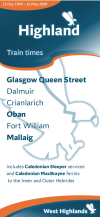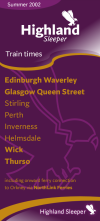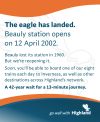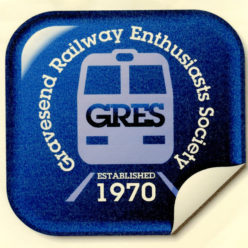backontrack
Established Member
Recently, I've got a kick out of using the Internet Wayback Machine to go and view past operators' old websites. For those that I just barely remember, there's a wrinkle of nostalgia; for others, it's more social anthropology. There's something almost childlike and naïve in the way those past operators used their websites, the particular attention paid to aspects of the railway like leisure-travel promotions and family activity packs, or in the graphic design — all OK Computer swooshes, New Labour understated typefaces, patterns fading out of white.
Indeed, that aspect of the visual design is something I find incredibly diverting. I'd suggest, as such a diversion, reading the excellent The Beauty of Transport blog post on Railtrack's visual identity, demonstrating how the company's vertiginous decline was reflected in the way Railtrack presented itself to its own shareholders. It demonstrates how these aspects of the railway smear together: so much is external messaging, visual narrative.
In a moment of excruciating boredom, I entertained a thought: what if, post-privatisation, the franchises had been hashed out differently — and we had a whole ream of different TOCs? Wales had its regional services split among several operators — North Western Trains (latterly First-owned), Central Trains, Wales and West — while Scotland's remained somewhat intact, integrated into the ScotRail franchise. And to some extent this is logical. Wales largely lacks direct, fast rail links between North/Mid Wales and the country's hub of power and commerce, with towns in those areas instead tending towards Liverpool, Manchester, or Birmingham. Conversely, Scotland's system is centred upon the Central Belt.
But imagine an illogical division of services. The 'InterCity' services — Edinburgh to Glasgow, and both of those cities to Dundee, Aberdeen, and Inverness — go to one operator. The Central Belt is split between a Glasgow-based, heavily SPT-influenced operation, and an Edinburgh-centred one (probably run by First).
That leaves an unfancied rump of diesel-operated Highland services. A group of recalcitrant managers bundle together and buy out the heavily subsidised operation. The franchise is called Highland Railways, but nobody is realistically abbreviating as 'HR', so they just become known as Highland. In 1999, they're bought out by Prism Rail. Here's a timetable that I scanned from that year of operation, via my trusty time machine:

This, rather hastily bundled-together, timetable concept combines elements of many post-privatisation TOCs — the colour scheme is pure Midland Mainline, the logo's nicked from Great Western, and what I'll term the 'swooshiness' was a universal trait of TOC comms around this time. Never mind that the font, 'Seaford', dates from 2023! Nowadays, the timetable looks rather cheap and tacky. This attempt, taken from the following year, aims for a touch more sobriety, with the company in dire financial straits:

Of course, 'Caledonian Sleeper' is a misnomer, because one of the consequences of privatisation was the splitting-up of this service into two distinct strands. Sea Containers, who took over the western intercity route, were attracted to the Lowland Sleeper routes, but didn't fancy the Highland ones. As a consequence, they were lumped into the Highland franchise. To give the TOC credit, they endeavoured to use the sleeper stock proactively, trialling a new 'Orkney Sleeper' on Saturday nights:

That colour scheme is very First.
The company's default look sat reasonably neatly on the Class 158 diesel multiple units the company used, although those offset orange stripes would prove quite divisive. It's ultimately a tackier rendition of what GNER and Midland Mainline did — while the deer logo broke gracefully through the stripes on the latter's trains, here the effect is a bit ungainly:

In 2004, the franchise was reintegrated back into a combined ScotRail franchise. And Highland Railways would remain an unfancied little curio from history. All that remained were the last vestiges of the company. This poster, from 2002, remained at Lochluichart station until 2007:

It was, at the very least, a bold endeavour.
Indeed, that aspect of the visual design is something I find incredibly diverting. I'd suggest, as such a diversion, reading the excellent The Beauty of Transport blog post on Railtrack's visual identity, demonstrating how the company's vertiginous decline was reflected in the way Railtrack presented itself to its own shareholders. It demonstrates how these aspects of the railway smear together: so much is external messaging, visual narrative.
In a moment of excruciating boredom, I entertained a thought: what if, post-privatisation, the franchises had been hashed out differently — and we had a whole ream of different TOCs? Wales had its regional services split among several operators — North Western Trains (latterly First-owned), Central Trains, Wales and West — while Scotland's remained somewhat intact, integrated into the ScotRail franchise. And to some extent this is logical. Wales largely lacks direct, fast rail links between North/Mid Wales and the country's hub of power and commerce, with towns in those areas instead tending towards Liverpool, Manchester, or Birmingham. Conversely, Scotland's system is centred upon the Central Belt.
But imagine an illogical division of services. The 'InterCity' services — Edinburgh to Glasgow, and both of those cities to Dundee, Aberdeen, and Inverness — go to one operator. The Central Belt is split between a Glasgow-based, heavily SPT-influenced operation, and an Edinburgh-centred one (probably run by First).
That leaves an unfancied rump of diesel-operated Highland services. A group of recalcitrant managers bundle together and buy out the heavily subsidised operation. The franchise is called Highland Railways, but nobody is realistically abbreviating as 'HR', so they just become known as Highland. In 1999, they're bought out by Prism Rail. Here's a timetable that I scanned from that year of operation, via my trusty time machine:

This, rather hastily bundled-together, timetable concept combines elements of many post-privatisation TOCs — the colour scheme is pure Midland Mainline, the logo's nicked from Great Western, and what I'll term the 'swooshiness' was a universal trait of TOC comms around this time. Never mind that the font, 'Seaford', dates from 2023! Nowadays, the timetable looks rather cheap and tacky. This attempt, taken from the following year, aims for a touch more sobriety, with the company in dire financial straits:

Of course, 'Caledonian Sleeper' is a misnomer, because one of the consequences of privatisation was the splitting-up of this service into two distinct strands. Sea Containers, who took over the western intercity route, were attracted to the Lowland Sleeper routes, but didn't fancy the Highland ones. As a consequence, they were lumped into the Highland franchise. To give the TOC credit, they endeavoured to use the sleeper stock proactively, trialling a new 'Orkney Sleeper' on Saturday nights:

That colour scheme is very First.
The company's default look sat reasonably neatly on the Class 158 diesel multiple units the company used, although those offset orange stripes would prove quite divisive. It's ultimately a tackier rendition of what GNER and Midland Mainline did — while the deer logo broke gracefully through the stripes on the latter's trains, here the effect is a bit ungainly:

In 2004, the franchise was reintegrated back into a combined ScotRail franchise. And Highland Railways would remain an unfancied little curio from history. All that remained were the last vestiges of the company. This poster, from 2002, remained at Lochluichart station until 2007:

It was, at the very least, a bold endeavour.




